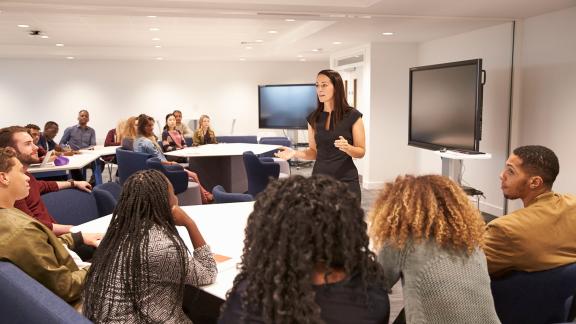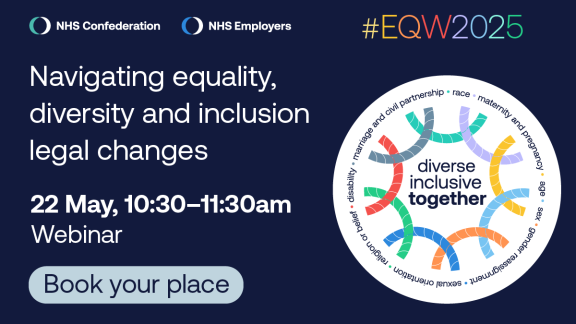Striking the balance: an approach to agile working

Following the pandemic and the rapid uptake of agile working at University Hospital Southampton NHS Foundation Trust (UHS), the trust wanted to embrace and implement agile working permanently to retain and attract talent, foster a dynamic and flexible work environment, and be able to adjust office occupancy levels to meet differing demands.
The delivery of agile working became a key commitment in the trust's People Strategy to help staff to thrive, excel and belong.
What the trust faced
New ways of working
In 2020, workforce expectations shifted dramatically due to the pandemic. UHS recognised the urgency to adapt and the need to develop a flexible model that created the right balance of on-site versus remote working. Recognising that one size doesn’t fit all while aligning with staff preferences and organisational needs was crucial to attract and retain top talent in a competitive market.
Projected growth and insufficient office space
Following the pandemic, the trust’s projected growth and the number of employees that were required to meet increasing service demands was putting pressure on available and suitable office space. If all agile workers were to return on-site, there wouldn’t have been enough space to accommodate them. Some office and administrative space had also been converted to clinical space during the pandemic.
Space and desk management issues
The trust had no way to correlate the number of employees on- site to the space available, meaning efficient use of space could not be achieved. In addition, staff were using inefficient methods to share desks amongst teams, often leading to additional stress due to misinformation and unavailability of desks.
Strengthening team cohesion
Remote working reduced team contact time, risking lower team spirit, connection, and employee inclusion/wellbeing if not managed properly.
What the trust did
Key stakeholders and decision makers from various functions were assembled to form a core working group, coordinated by a project lead.
One of the initial actions from this working group was to conduct a survey among existing agile workers, to identify their balance of on-site versus remote working, any issues faced and the benefits they experienced. The survey findings helped define three workstreams of activity with the following key actions.
Workstream 1 - People:
- Secured senior stakeholder buy-in for the long-term adoption of agile working.
- Sought feedback from unions and staff networks including the long-term illness and disability group and one voice network.
- Defined key principles such as criteria for eligibility, appropriate balance of on-site vs. remote working, equipment needs etc.
- Updated agile working policy to include agile and contractual home working definitions and many other useful elements following the introduction of Section 35 of the NHS Terms and Conditions of Service (TCS) Handbook.
- Recognised the need to sustain team belonging within a hybrid and digital working environment. Developed and delivered relevant training.
- Revised recruitment adverts to specify roles offering agile working and reinforce opportunities for flexibility.
Workstream 2 - Property:
- Analysed the working arrangements of corporate functions to determine desk requirements.
- Following the need to return to site, use shared offices, and as a response to feedback, several kitchens were refurbished, windows replaced, and offices repainted. For some roles that could be done almost entirely remotely, these improvements encouraged staff to return to on-site working.
Workstream 3 - Technology:
- Secured funding for a desk/room booking system (Matrix), now used by over 1,000 staff across ten buildings.
- Secured funding to improve standardisation of equipment within the largest staff group of agile workers for example, workstations, docking stations, screens etc.
Overcoming obstacles
- Overcoming historical culture of how and where work was completed was necessary to truly embrace agile working. It was achieved by using key sponsors, stakeholders and ensuring agile working was a regular topic of discussion at all levels of the organisation.
- While UHS continue to learn, the high-level principles that took time to agree on have helped the trust to navigate decisions surrounding this relatively new way of working.
- Despite reduced commuting costs and improved comfort from remote working, encouraging staff to return on-site involved addressing confidentiality concerns, balancing service needs with personal commitments, and ensuring visibility and face-to-face team collaboration. This return to on-site working was crucial for indirect learning, especially for new starters.
- The trust’s agile working policy/procedure and the adoption of section 35 of the NHS TCS Handbook requires managers to apply judgement and discretion, balancing all the various needs. The comfort levels of managers to hold these discussions was varied, therefore differing levels of support were required.
- Progress was helped by a willingness to adapt if agreements weren’t working or suitable for service needs.
Results and benefits
Agile working
Agile working has been widely adopted, leading to increased productivity, positive work-life balance, and job satisfaction among employees. Embracing agile working has ensured UHS is in the best position to attract and retain candidates. It has also helped to fill hard to recruit specialist roles.
Anecdotal evidence shows that agile working is helping to retain and engage staff that may otherwise be excluded. In addition, the broad approach to agile working and flexibility is a key reason staff survey responses on work-life balance have improved.
The agile working toolkit (case studies, policy, procedure, online webinar training etc) has provided managers and teams with clear guidelines on how to implement agile working for new and existing staff.
Remote clinics have provided benefits such as time efficiency, reduced car parking costs, and increased comfort for patients, while clinicians have seen fewer missed appointments and improved work-life balance.
Environment and use of space
Enhancements in work environments, investment in equipment and the desk booking system have all encouraged desk sharing. Many departments are, for the first time, sharing desks and space with other departments.
Data from the desk booking system, Matrix, has enabled ongoing analysis of office/desk use and continues to inform medium to long-term decisions. A significant number of desks and underutilised space has been released from teams with surplus to those that were under-resourced (largely to clinical teams) with potential cost avoidance of c£275,000.
Underused office space has been repurposed to meet new needs, such as hot desks for any staff, one-to-one rooms, and team-day areas (for when larger on-site presence of teams lead to increased need in desks).
UHS continues to review space usage, employee engagement and where else agile working could be adopted to greater enhance employee engagement, retention, and productivity.
Takeaway tips
- Take a strategic decision to embrace agile working. This needs to be given time and attention and be supported and endorsed by senior leadership.
- Take time to get it right. Listen to staff concerns and be prepared to be open minded.
- Recognise that not all service areas/roles are appropriate for agile working. This may lead to feelings of division if not managed up front. It's important to have the difficult conversations.
Contact details
For more information about the work in this case study, contact Victoria Colam, HR project manager, University Hospital Southampton NHS Foundation Trust.



